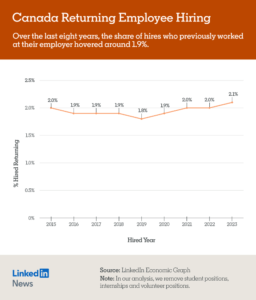This week, a surprising headline took LinkedIn News by storm: “Why returning hires are coming back.” We find this surprising because, as the author of the news article Riva Gold notes, for many, there is a taboo associated with an employee returning to a previous place of work—for employees and employers alike. It seems like a messy practice to take up, no? So, why should you rehire a former employee?
We’ve got some pretty compelling arguments as well as ways to not sever ties when an employee approaches you with a letter of resignation below!
Why Employees Are Returning to Former Workplaces
If you are as surprised as we are to hear about this new trend in hiring, it might be because of the existing taboos associated with returning to a former workplace, or even being the one doing the rehiring. That is, many believe rehiring former employees is generally speaking a bad practice for everyone involved.
This may be because the employee may feel like the employer will hold onto any hard feelings that may have arisen with their first resignation. And even if that tension doesn’t actually exist, many employees may perceive it between you and the former employee and feel uncomfortable as a result.
But as it turns out, this taboo has really shifted in the past few years. In fact, according to a Robert Half press release from this time last year, 65% per cent of managers have rehired former employees with whom they parted ways on good terms. And this isn’t just because hiring a former employee is easier to onboard the second time around.

Just as the statistics suggest, there are many reasons why you should rehire a former employee. Here are just a few reasons why rehiring a former employee can be a beneficial move for you and the employee alike.
Why You Should Rehire a Former Employee
As the aforementioned Robert Half article mentions, the following are the top reasons employers have decided to start rehiring former employees.
Company-Specific Knowledge and Experience
Perhaps the best part of rehiring a former employee is their company- and industry-specific knowledge and experience. In fact, 22% of managers surveyed by the Robert Half company who said they would rehire a former employee say that the biggest benefit of doing so was the employee’s existing skills, knowledge, and experience.
This is because you already know they know the ropes at your organization and in the industry in general, so you won’t need to confirm they’ll be able to keep up. After all, if you’ve already offered them a soft-skills assessment—like Packfinder, for instance—you would have already confirmed their suitability for the position and industry as a whole.
Proven Abilities to Perform
Similarly, another 22% of the managers surveyed said that the biggest benefit of having a returning employee is knowing their abilities to perform. That is, as opposed to hiring someone new who claims to have a skill set or shows experience on their resume, a returning employee has already proven to you that they have the skills needed to succeed at your organization.
So, re-hiring, especially when you need certain levels of performance from your employees, is kind of a no-brainer.
Fast and Efficient Re-Integration
Another 21% of those surveyed said that quick assimilation and contribution was a huge factor for rehiring former employees.
Considering it can take a new employee upwards of 6 months on the job to meet the standards of your organization, rehiring an employee whose re-integration is sure to be quick and painless is quite the obvious benefit. And, of course, this speedy integration isn’t just because the employee knows their position and the organization already. It also has to do with gelling and already having a history with other employees and C-suite members.
So, as long as you and your former employee last ended on good terms, you really only have the above to lose if you don’t rehire them.
A second chance to make improvements
What better way to prove to yourself and others that you’re willing and able to make changes across your organization than learning from mistakes that may have lead to a former employee’s resignation? And even if you personally weren’t the sole reason for your employee having left the first time around, getting them back on your team can help you know what drove them away in the first place and how to retain not only them but other employees as well.
But crucially: never take advantages of second chances. Opportunities like these can be rare, so treat them as such. Take care and make sure you’re improving your employees’ experiences by learning from previous mistakes and ensuring a better work experience for everyone on the team.
How to Say Goodbye without Severing Ties
As previously mentioned, welcoming back a former employee often means having been on good terms when parting ways the first time. And, especially when you had a good rapport with or trust in a former employee before they resigned, it can be tough to say goodbye without severing ties.
But, as Rebecca Zucker notes in her article for Harvard Business Review, “Someone giving notice doesn’t have to be the end of the world or the end of a relationship.” What’s more, as this blog suggests, someone giving notice shouldn’t be the end of a relationship; after all, it may not be the end at all!
So, as Zucker suggests, when an employee approaches you with a letter of resignation, start by:
1. Taking a Breath to React Calmly
As Zucker notes, sometimes resignations can catch us off-guard. You’re allowed to feel surprised, and even admit to the employee that you’re surprised to hear the news. But, crucially, take a breath before you say something that might put a wedge between you and the employee.
2. Managing the way these emotions come out
To avoid severing ties or making the employee feel as though they’ve burned a bridge between the two of you, make sure you’re carefully expressing any emotions you want to share with them. If you feel yourself wanting to express your sadness or disappointment in their resignation, you can do so, as Zucker suggests, by simply stating you’re sad to see them go, but are happy for their new opportunities elsewhere.
This shows you care about their wellbeing and career trajectory, even if it isn’t in your absolute best favour. After all, you never know if (or when) they’ll be back.
3. Depersonalizing the news
This may come more naturally when you take a step back from the situation, but when your employee approaches you with their letter of resignation, be sure to show them that you recognize their resignation is not personal. Certainly, you can feel sad about losing a team member, but try not to feel (nor show) that they’re resigning because of something personal about you. It never is personal; it’s always about better opportunities for their career elsewhere.
4. Showing care and curiosity
This brings us to the last step: showing interest in their future and asking what’s next for them. You can even, as Zucker suggests, ask them what it might take for them to stay with the company. But, of course, don’t let your want to keep them here takeover your well wishes for them elsewhere.
By all means, ask them about what it is that brings them elsewhere and what they can anticipate in their new position, but make sure they know this is coming from a good place. Express your well wishes to them and, if they agree to, stay in touch either via a social media account like LinkedIn or via email or phone. This will show you care and want to hear from them, even if they are happy where they end up next.
Do you have any advice for not severing ties with soon-to-be former employees? Have you ever re-hired a team member before? We want to hear from you! Leave a comment on our LinkedIn post for this blog to share your stories and insights with us.





